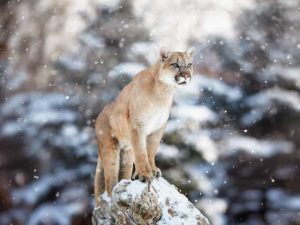Updated on: 31/08/2023
The Eastern Cougar, also known as the eastern puma, was a large feline that has officially been pronounced extinct by the authorities. However, not everyone agrees that these cats from eastern North America are extinct. Interestingly, claims about sightings of eastern cougar paw or footprints, tracks, droppings, and even the animals themselves have now been on the increase.
| Kingdom: | Animalia |
| Phylum: | Chordata |
| Class: | Mammalia |
| Order: | Carnivora |
| Suborder: | Feliformia |
| Family: | Felidae |
| Subfamily: | Felinae |
| Genus: | Puma |
| Species: | P. concolor |
| Subspecies: | †P. c. couguar |
| Trinomial/Scientific Name: | Puma concolor couguar |
| Size: | Up to 2.4 meters (8 ft) in length (nose to tail) |
| Height: | 60 to 76 cm (2.0 to 2.5 ft) tall at the shoulders |
| Weight: | Anything between 29 and 90 kilograms (64 and 198 pounds) |
| Average Lifespan: | About 8-12 years |
| Location/Distribution & Habitat: | Lived in a variety of habitats, including deserts, mountainous terrain, tidal marshes, and deciduous, coniferous and tropical forests of north-eastern regions of North America |
| Diet: | Carnivorous |
| Birth Type (Reproduction): | Viviparous |
| Locomotion: | Quadruped |
| Conservation Status: | ‘TX’ (Presumed Extinct, 2016, NatureServe) |
Unofficially, in 2011, this long-tailed puma subspecies was considered to be extinct by an evaluation conducted by the U.S. Fish and Wildlife Service.
Then after, in 2011, the Fish and Wildlife Service opened an elaborate review about the status of the creature. In 2015, the agency inferred that the animal does not need to be protected under the Endangered Species Act and decided to de-list it.
In the same year, a group of scholars and students from the Pennsylvania State University formed a group to research about the sequence of the mitochondrial DNA genome of this subspecies that they understood to have already gone extinct.
Finally, in 2018, the Fish and Wildlife Service organization formally removed the mammal from the list of endangered species by declaring the feline extinct. The Canadian Wildlife Service, however, has not yet taken any stance on the question.
On January 22, 2018, the de-listing was finalized, while the cats were officially declared extinct. However, according to a statement released by the Center for Biological Diversity – The eastern cougar was extinct well before it was protected under the Endangered Species Act, as was the case with eight of the other ten species that have been de-listed for extinction.
Also known as catamount, mountain lion, panther, these cats had a characteristic long tail of about 3 feet in length. This was an adaptation to help them maintain balance and steer directions swiftly while chasing prey.
The males of the species were larger than their female counterparts. They had long but slender bodies with a rather small, broad, and rounded heads. Their ears were short, erect and round.
The entire body of the eastern puma was covered with short tan to light brown fur that turned tawnier in the summer months and grayer during the winter. This evolution of body color was probably an adaptation for camouflage amidst the dry summer leaves and grayish/whitish winter snow.
Their chin, muzzle and the underparts were creamy to dull white whereas the tip of the tail, the back of the ears, and the base of the whiskers had some black coloration. The baby cougars were rather paler than the adults, but with characteristic dark spots on the flank region.
Eastern pumas were solitary, territorial hunters. The males usually protected their territories from other males by making scrapes by making a pile of pine needles, leaves and twigs and urinating upon it.
These mammals were active during both day and night, but were likely to be most active at dusk and dawn.
The main source of food of the eastern puma was the white-tailed deer. These carnivores would kill and consume meat from one deer for around 7 to 10 days.
However, the big cat will also hunt and feed on various other species of smaller animals including elks, rabbits, raccoons, porcupines, and even mice, or occasionally attack domestic livestock too.
